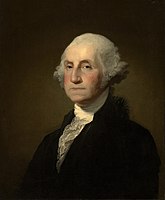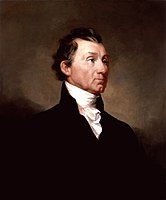
John Quincy Adams was an American statesman, politician, diplomat, lawyer, and diarist who served as the sixth president of the United States, from 1825 to 1829. He previously served as the eighth United States secretary of state from 1817 to 1825. During his long diplomatic and political career, Adams served as an ambassador and also as a member of the United States Congress representing Massachusetts in both chambers. He was the eldest son of John Adams, who served as the second president of the United States from 1797 to 1801, and First Lady Abigail Adams. Initially a Federalist like his father, he won election to the presidency as a member of the Democratic-Republican Party, and later, in the mid-1830s, became affiliated with the Whig Party.
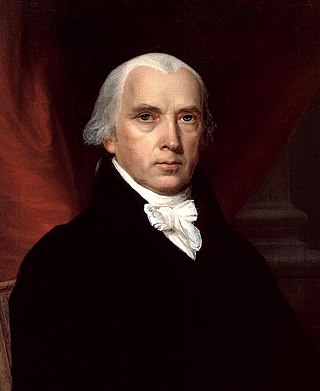
James Madison was an American statesman, diplomat, and Founding Father who served as the fourth president of the United States from 1809 to 1817. Madison was popularly acclaimed the "Father of the Constitution" for his pivotal role in drafting and promoting the Constitution of the United States and the Bill of Rights.

James Monroe was an American statesman, lawyer, diplomat, and Founding Father who served as the fifth president of the United States from 1817 to 1825, a member of the Democratic-Republican Party. He was the last Founding Father to serve as president as well as the last president of the Virginia dynasty. His presidency coincided with the Era of Good Feelings, concluding the First Party System era of American politics. He issued the Monroe Doctrine, a policy of limiting European colonialism in the Americas. Monroe previously served as governor of Virginia, a member of the United States Senate, U.S. ambassador to France and Britain, the seventh secretary of state, and the eighth secretary of war.

The Republican Party, retroactively called the Democratic-Republican Party, and also referred to as the Jeffersonian Republican Party among other names, was an American political party founded by Thomas Jefferson and James Madison in the early 1790s that championed liberalism, republicanism, individual liberty, equal rights, decentralization, free markets, free trade, agrarianism, and sympathy with the French Revolution. The party became increasingly dominant after the 1800 elections as the opposing Federalist Party collapsed.

The Federalist Party was a conservative and nationalist American political party and the first political party in the United States. It dominated the national government under Alexander Hamilton from 1789 to 1801. The party was defeated by the Democratic-Republican Party in 1800, and it became a minority party while keeping its stronghold in New England. It made a brief resurgence by opposing the War of 1812, then collapsed with its last presidential candidate in 1816. Remnants lasted for a few years afterwards.

The 1792 United States presidential election was the second quadrennial presidential election. It was held from Friday, November 2, to Wednesday, December 5, 1792. Incumbent President George Washington was elected to a second term by a unanimous vote in the electoral college, while John Adams was re-elected as vice president. Washington was essentially unopposed, but Adams faced a competitive re-election against Governor George Clinton of New York.

The 1796 United States presidential election was the third quadrennial presidential election of the United States. It was held from Friday, November 4 to Wednesday, December 7, 1796. It was the first contested American presidential election, the first presidential election in which political parties played a dominant role, and the only presidential election in which a president and vice president were elected from opposing tickets. Incumbent vice president John Adams of the Federalist Party defeated former secretary of state Thomas Jefferson of the Democratic-Republican Party.

The 1808 United States presidential election was the sixth quadrennial presidential election, held from Friday, November 4, to Wednesday, December 7, 1808. The Democratic-Republican candidate James Madison defeated Federalist candidate Charles Cotesworth Pinckney decisively.

The 1816 United States presidential election was the eighth quadrennial presidential election. It was held from November 1 to December 4, 1816. In the first election following the end of the War of 1812, Democratic-Republican candidate James Monroe defeated Federalist Rufus King. The election was the last in which the Federalist Party fielded a presidential candidate.

The 1820 United States presidential election was the ninth quadrennial presidential election. It was held from Wednesday, November 1, to Wednesday, December 6, 1820. Taking place at the height of the Era of Good Feelings, the election saw incumbent Democratic-Republican President James Monroe win re-election without a major opponent. It was the third and the most recent United States presidential election in which a presidential candidate ran effectively unopposed. As of 2024, this is the most recent presidential election where an incumbent president was re-elected who was neither a Democrat nor a Republican, before the Democratic-Republican party split into separate parties.

The 1824 United States presidential election was the tenth quadrennial presidential election. It was held from Tuesday, October 26 to Thursday, December 2, 1824. Andrew Jackson, John Quincy Adams, Henry Clay and William Crawford were the primary contenders for the presidency. The result of the election was inconclusive, as no candidate won a majority of the electoral vote. In the election for vice president, John C. Calhoun was elected with a comfortable majority of the vote. Because none of the candidates for president garnered an electoral vote majority, the U.S. House of Representatives, under the provisions of the Twelfth Amendment, held a contingent election. On February 9, 1825, the House voted to elect John Quincy Adams as president, ultimately giving the election to him.
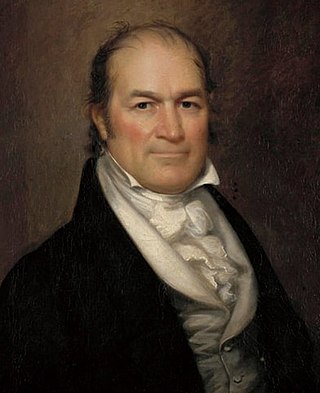
William Harris Crawford was an American politician and judge during the early 19th century. He served as US Secretary of War and US Secretary of the Treasury before he ran for US president in the 1824 election.

The Era of Good Feelings marked a period in the political history of the United States that reflected a sense of national purpose and a desire for unity among Americans in the aftermath of the War of 1812. The era saw the collapse of the Federalist Party and an end to the bitter partisan disputes between it and the dominant Democratic-Republican Party during the First Party System. President James Monroe strove to downplay partisan affiliation in making his nominations, with the ultimate goal of national unity and eliminating political parties altogether from national politics. The period is so closely associated with Monroe's presidency (1817–1825) and his administrative goals that his name and the era are virtually synonymous.
The congressional nominating caucus is the name for informal meetings in which American congressmen would agree on whom to nominate for the presidency and vice presidency from their political party.

The presidency of James Madison began on March 4, 1809, when James Madison was inaugurated as President of the United States, and ended on March 4, 1817. Madison, the fourth United States president, took office after defeating Federalist Charles Cotesworth Pinckney decisively in the 1808 presidential election. He was re-elected four years later, defeating DeWitt Clinton in the 1812 election. His presidency was dominated by the War of 1812 with Britain. After serving two terms as president, Madison was succeeded in 1817 by James Monroe, his Secretary of State and a fellow member of the Democratic-Republican Party.
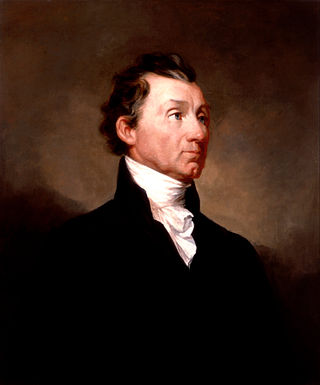
The presidency of James Monroe began on March 4, 1817, when James Monroe was inaugurated as President of the United States, and ended on March 4, 1825. Monroe, the fifth United States president, took office after winning the 1816 presidential election by an overwhelming margin over Federalist Rufus King. This election was the last in which the Federalists fielded a presidential candidate, and Monroe was unopposed in the 1820 presidential election. A member of the Democratic-Republican Party, Monroe was succeeded by his Secretary of State John Quincy Adams.
The 1808 United States Senate election in Massachusetts was held on June 2, 1808.

Electoral history of John Adams, who had served as the second president of the United States (1797–1801) and the first vice president of the United States (1789–1797). Prior to being president, he had diplomatic experience as the second United States envoy to France (1777–1779), the first United States minister to the Netherlands (1782–1788), and the first United States minister to the United Kingdom (1785–1788). After losing the 1800 presidential election to Thomas Jefferson, he would mostly retire from political life, with his second youngest son, John Quincy Adams (1767–1848), being elected as the sixth President of the United States (1825–1829) in the 1824 presidential election against Tennessee Senator Andrew Jackson.
